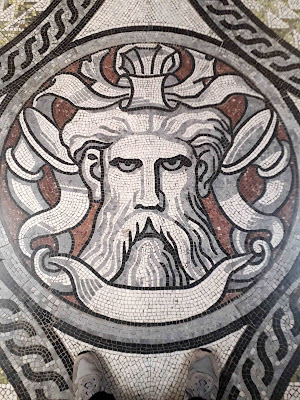Looking
‘Under my feet’ began as a series of ‘shoe selfies’ (I detest having my photo
taken so seldom take face selfies), taken on my phone (so the photos are not very
good quality) for posting on my Instagram account. But, almost immediately, I
began to see noteworthy things under my feet and to realise how often I look up
and around but not down.
I have now begun to appreciate much more what lies
beneath my feet and will occasionally blog about what I photograph. The
subjects will probably be varied and a little random but hopefully interesting.
This
first series of three photos was taken during a three-night stay in London at
the end of October, a stay which included my first ever visit to the Victoria and Albert Museum, a museum that had long been on my
list of must-visit places. As we were on a mission to give an Australian
friend a brief taste of London’s famous sites, we didn’t stay long at the V&A
so I am already planning a return visit but, as well as all the incredible
exhibits that constantly drew my eyes up and around, I did make a point of
looking down and so I couldn’t help but notice the incredible mosaic floors.
For my first ‘shoe selfie’ the design (photo above left) was a
simple one but, as we visited other rooms within the museum, the mosaic designs
just kept getting better and better. And I’ve now discovered that they have
their own story to tell, a fascinating story of female convicts.
This
is from a blog on the V&A’s website:
Starting in
1869, women from Woking Prison were employed in gangs. Using fragments of
refuse marble, which they chipped into suitable sized pieces, they assembled
blocks or ‘tiles’ of mosaic. These were then rubbed down to a level surface
using a piece of York stone. The result became known as Opus Criminale.
The
‘Opus criminale’ was made by the women prisoners between about 1869 and 1873,
following a design by Francis Wollaston Moody (1824-1886). Apparently, the idea
of using convict labour, which was approved by the Home Secretary, was proposed
by one Captain Du Cane, then a prison official, who went on to become ‘surveyor-general of prisons, chairman of the convict prison
directors and inspector-general of military prisons’.
Not
all the museum’s mosaic floors were produced using prison labour: Moody’s
designs, which included masks, sea creatures (like the dolphins included
in the corner panel above) and geometric patterns, had originally
been created for a landing on the West or Ceramic Staircase (now identified as
Staircase I), which was crafted by the famous firm of Minton, Hollins & Company.
Once
that section had been completed, the designs were extended and the women
prisoners’ work used for the additional floors, for the corridor between the
Cast Courts (which is where I took the photo of the bearded man – possibly Poseidon),
the cloister beneath the Sheepshanks Gallery (now the
Museum bookshop), the Science Schools (now the Henry Cole Wing), and also for part
of the V&A Museum of Childhood, a separate museum located in Bethnal Green.
So, if you get the chance to visit the
Victoria and Albert Museum, do try to tear your eyes away from the wealth of
stunning designs all around you to take a few moments to appreciate these
remarkable floors.



No comments:
Post a Comment